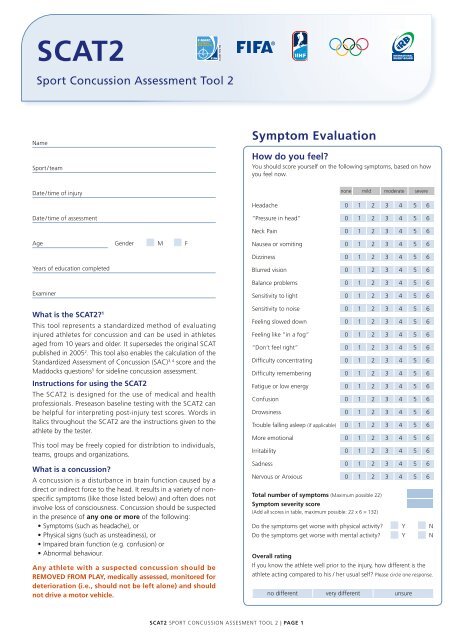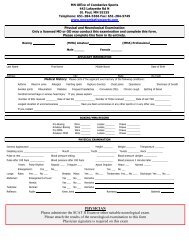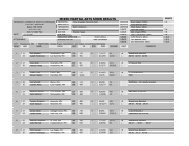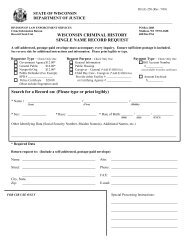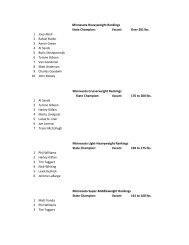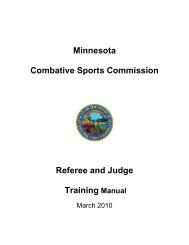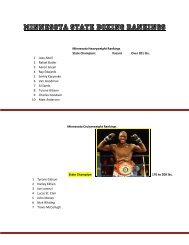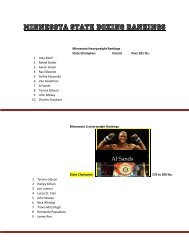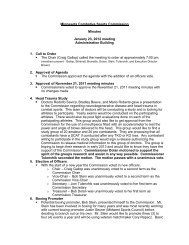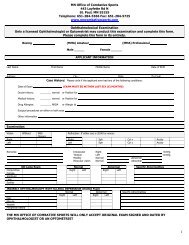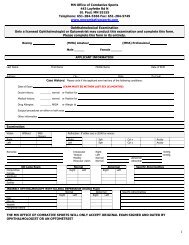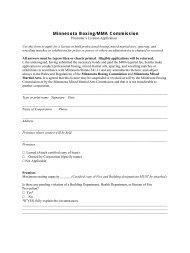Sport Concussion Assessment Tool 2
Sport Concussion Assessment Tool 2
Sport Concussion Assessment Tool 2
Create successful ePaper yourself
Turn your PDF publications into a flip-book with our unique Google optimized e-Paper software.
SCAT2<br />
<strong>Sport</strong> <strong>Concussion</strong> <strong>Assessment</strong> <strong>Tool</strong> 2<br />
name<br />
<strong>Sport</strong> / team<br />
Date / time of injury<br />
Date / time of assessment<br />
Age Gender n M n F<br />
Years of education completed<br />
examiner<br />
What is the SCAT2? 1<br />
This tool represents a standardized method of evaluating<br />
injured athletes for concussion and can be used in athletes<br />
aged from 10 years and older. It supersedes the original SCAT<br />
published in 20052 . This tool also enables the calculation of the<br />
Standardized <strong>Assessment</strong> of <strong>Concussion</strong> (SAC) 3, 4 score and the<br />
Maddocks questions5 for sideline concussion assessment.<br />
Instructions for using the SCAT2<br />
The SCAT2 is designed for the use of medical and health<br />
professionals. Preseason baseline testing with the SCAT2 can<br />
be helpful for interpreting post-injury test scores. Words in<br />
Italics throughout the SCAT2 are the instructions given to the<br />
athlete by the tester.<br />
This tool may be freely copied for distribtion to individuals,<br />
teams, groups and organizations.<br />
What is a concussion?<br />
A concussion is a disturbance in brain function caused by a<br />
direct or indirect force to the head. It results in a variety of nonspecific<br />
symptoms (like those listed below) and often does not<br />
involve loss of consciousness. <strong>Concussion</strong> should be suspected<br />
in the presence of any one or more of the following:<br />
• Symptoms (such as headache), or<br />
• Physical signs (such as unsteadiness), or<br />
• Impaired brain function (e.g. confusion) or<br />
• Abnormal behaviour.<br />
Any athlete with a suspected concussion should be<br />
REMOVED FROM PLAY, medically assessed, monitored for<br />
deterioration (i.e., should not be left alone) and should<br />
not drive a motor vehicle.<br />
SCAT2 SPorT ConCuSSIon ASSeSMenT <strong>Tool</strong> 2 | PAgE 1<br />
Symptom Evaluation<br />
How do you feel?<br />
You should score yourself on the following symptoms, based on how<br />
you feel now.<br />
none mild moderate severe<br />
Headache 0 1 2 3 4 5 6<br />
“Pressure in head” 0 1 2 3 4 5 6<br />
neck Pain 0 1 2 3 4 5 6<br />
nausea or vomiting 0 1 2 3 4 5 6<br />
Dizziness 0 1 2 3 4 5 6<br />
Blurred vision 0 1 2 3 4 5 6<br />
Balance problems 0 1 2 3 4 5 6<br />
Sensitivity to light 0 1 2 3 4 5 6<br />
Sensitivity to noise 0 1 2 3 4 5 6<br />
Feeling slowed down 0 1 2 3 4 5 6<br />
Feeling like “in a fog“ 0 1 2 3 4 5 6<br />
“Don’t feel right” 0 1 2 3 4 5 6<br />
Difficulty concentrating 0 1 2 3 4 5 6<br />
Difficulty remembering 0 1 2 3 4 5 6<br />
Fatigue or low energy 0 1 2 3 4 5 6<br />
Confusion 0 1 2 3 4 5 6<br />
Drowsiness 0 1 2 3 4 5 6<br />
Trouble falling asleep (if applicable) 0 1 2 3 4 5 6<br />
More emotional 0 1 2 3 4 5 6<br />
Irritability 0 1 2 3 4 5 6<br />
Sadness 0 1 2 3 4 5 6<br />
nervous or Anxious 0 1 2 3 4 5 6<br />
Total number of symptoms (Maximum possible 22)<br />
Symptom severity score<br />
(Add all scores in table, maximum possible: 22 x 6 = 132)<br />
Do the symptoms get worse with physical activity? Y n<br />
Do the symptoms get worse with mental activity? Y n<br />
Overall rating<br />
If you know the athlete well prior to the injury, how different is the<br />
athlete acting compared to his / her usual self? Please circle one response.<br />
no different very different unsure
1<br />
2<br />
3<br />
4<br />
Cognitive & Physical Evaluation<br />
Symptom score (from page 1)<br />
22 minus number of symptoms of 22<br />
Physical signs score<br />
Was there loss of consciousness or unresponsiveness? Y n<br />
If yes, how long? minutes<br />
Was there a balance problem / unsteadiness? Y n<br />
Physical signs score (1 point for each negative response) of 2<br />
glasgow coma scale (gCS)<br />
Best eye response (E)<br />
no eye opening<br />
eye opening in response to pain<br />
eye opening to speech<br />
eyes opening spontaneously<br />
Best verbal response (V)<br />
no verbal response<br />
Incomprehensible sounds<br />
Inappropriate words<br />
Confused<br />
oriented<br />
Best motor response (M)<br />
no motor response<br />
extension to pain<br />
Abnormal flexion to pain<br />
Flexion / Withdrawal to pain<br />
localizes to pain<br />
obeys commands<br />
glasgow Coma score (E + V + M) of 15<br />
GCS should be recorded for all athletes in case of subsequent deterioration.<br />
Sideline <strong>Assessment</strong> – Maddocks Score<br />
“I am going to ask you a few questions, please listen carefully<br />
and give your best effort.”<br />
Modified Maddocks questions (1 point for each correct answer)<br />
At what venue are we at today? 0 1<br />
Which half is it now? 0 1<br />
Who scored last in this match? 0 1<br />
What team did you play last week / game? 0 1<br />
Did your team win the last game? 0 1<br />
Maddocks score of 5<br />
Maddocks score is validated for sideline diagnosis of concussion only and is not<br />
included in SCAT 2 summary score for serial testing.<br />
1 rd<br />
This tool has been developed by a group of international experts at the 3<br />
International Consensus meeting on <strong>Concussion</strong> in <strong>Sport</strong> held in Zurich,<br />
Switzerland in november 2008. The full details of the conference outcomes<br />
and the authors of the tool are published in British Journal of <strong>Sport</strong>s<br />
Medicine, 2009, volume 43, supplement 1.<br />
The outcome paper will also be simultaneously co-published in the May<br />
2009 issues of Clinical Journal of <strong>Sport</strong>s Medicine, Physical Medicine &<br />
rehabilitation, Journal of Athletic Training, Journal of Clinical neuroscience,<br />
Journal of Science & Medicine in <strong>Sport</strong>, neurosurgery, Scandinavian Journal<br />
of Science & Medicine in <strong>Sport</strong> and the Journal of Clinical <strong>Sport</strong>s Medicine.<br />
2 McCrory P et al. Summary and agreement statement of the 2 nd International<br />
Conference on <strong>Concussion</strong> in <strong>Sport</strong>, Prague 2004. British Journal of <strong>Sport</strong>s<br />
Medicine. 2005; 39: 196-204<br />
1<br />
2<br />
3<br />
4<br />
1<br />
2<br />
3<br />
4<br />
5<br />
1<br />
2<br />
3<br />
4<br />
5<br />
6<br />
Cognitive assessment<br />
Standardized <strong>Assessment</strong> of <strong>Concussion</strong> (SAC)<br />
Orientation (1 point for each correct answer)<br />
What month is it? 0 1<br />
What is the date today? 0 1<br />
What is the day of the week? 0 1<br />
What year is it? 0 1<br />
What time is it right now? (within 1 hour) 0 1<br />
Orientation score of 5<br />
Immediate memory<br />
“I am going to test your memory. I will read you a list of words<br />
and when I am done, repeat back as many words as you can<br />
remember, in any order.”<br />
Trials 2 & 3:<br />
“I am going to repeat the same list again. Repeat back as many<br />
words as you can remember in any order, even if you said the<br />
word before.“<br />
Complete all 3 trials regardless of score on trial 1 & 2. read the words at a rate<br />
of one per second. Score 1 pt. for each correct response. Total score equals sum<br />
across all 3 trials. Do not inform the athlete that delayed recall will be tested.<br />
list Trial 1 Trial 2 Trial 3 Alternative word list<br />
elbow 0 1 0 1 0 1 candle baby finger<br />
apple 0 1 0 1 0 1 paper monkey penny<br />
carpet 0 1 0 1 0 1 sugar perfume blanket<br />
saddle 0 1 0 1 0 1 sandwich sunset lemon<br />
bubble 0 1 0 1 0 1 wagon iron insect<br />
Total<br />
Immediate memory score of 15<br />
Concentration<br />
Digits Backward:<br />
“I am going to read you a string of numbers and when I am done,<br />
you repeat them back to me backwards, in reverse order of how I<br />
read them to you. For example, if I say 7-1-9, you would say 9-1-7.”<br />
If correct, go to next string length. If incorrect, read trial 2. one point possible for<br />
each string length. Stop after incorrect on both trials. The digits should be read at<br />
the rate of one per second.<br />
Alternative digit lists<br />
4-9-3 0 1 6-2-9 5-2-6 4-1-5<br />
3-8-1-4 0 1 3-2-7-9 1-7-9-5 4-9-6-8<br />
6-2-9-7-1 0 1 1-5-2-8-6 3-8-5-2-7 6-1-8-4-3<br />
7-1-8-4-6-2 0 1 5-3-9-1-4-8 8-3-1-9-6-4 7-2-4-8-5-6<br />
Months in Reverse Order:<br />
“Now tell me the months of the year in reverse order. Start<br />
with the last month and go backward. So you’ll say December,<br />
November ... Go ahead”<br />
1 pt. for entire sequence correct<br />
SCAT2 SPorT ConCuSSIon ASSeSMenT <strong>Tool</strong> 2 | PAgE 2<br />
5<br />
Dec-nov-oct-Sept-Aug-Jul-Jun-May-Apr-Mar-Feb-Jan 0 1<br />
Concentration score of 5<br />
3 McCrea M. Standardized mental status testing of acute concussion. Clinical<br />
Journal of <strong>Sport</strong>s Medicine. 2001; 11: 176-181<br />
4 McCrea M, randolph C, Kelly J. Standardized <strong>Assessment</strong> of <strong>Concussion</strong>:<br />
Manual for administration, scoring and interpretation. Waukesha,<br />
Wisconsin, uSA.<br />
5 Maddocks, Dl; Dicker, GD; Saling, MM. The assessment of orientation<br />
following concussion in athletes. Clin J <strong>Sport</strong> Med. 1995;5(1):32–3<br />
6 Guskiewicz KM. <strong>Assessment</strong> of postural stability following sport-related<br />
concussion. Current <strong>Sport</strong>s Medicine reports. 2003; 2: 24-30
6 Balance examination<br />
7<br />
This balance testing is based on a modified version of the Balance error Scoring<br />
System (BeSS) 6 . A stopwatch or watch with a second hand is required for this<br />
testing.<br />
Balance testing<br />
“I am now going to test your balance. Please take your shoes<br />
off, roll up your pant legs above ankle (if applicable), and<br />
remove any ankle taping (if applicable). This test will consist<br />
of three twenty second tests with different stances.“<br />
(a) Double leg stance:<br />
“The first stance is standing with your feet together with your<br />
hands on your hips and with your eyes closed. You should try<br />
to maintain stability in that position for 20 seconds. I will be<br />
counting the number of times you move out of this position. I<br />
will start timing when you are set and have closed your eyes.“<br />
(b) Single leg stance:<br />
“If you were to kick a ball, which foot would you use? [This<br />
will be the dominant foot] Now stand on your non-dominant<br />
foot. The dominant leg should be held in approximately 30<br />
degrees of hip flexion and 45 degrees of knee flexion. Again,<br />
you should try to maintain stability for 20 seconds with your<br />
hands on your hips and your eyes closed. I will be counting<br />
the number of times you move out of this position. If you<br />
stumble out of this position, open your eyes and return to<br />
the start position and continue balancing. I will start timing<br />
when you are set and have closed your eyes.“<br />
(c) Tandem stance:<br />
“Now stand heel-to-toe with your non-dominant foot in<br />
back. Your weight should be evenly distributed across both<br />
feet. Again, you should try to maintain stability for 20 seconds<br />
with your hands on your hips and your eyes closed. I will be<br />
counting the number of times you move out of this position.<br />
If you stumble out of this position, open your eyes and return<br />
to the start position and continue balancing. I will start timing<br />
when you are set and have closed your eyes.”<br />
Balance testing – types of errors<br />
1. Hands lifted off iliac crest<br />
2. opening eyes<br />
3. Step, stumble, or fall<br />
4. Moving hip into > 30 degrees abduction<br />
5. lifting forefoot or heel<br />
6. remaining out of test position > 5 sec<br />
each of the 20-second trials is scored by counting the errors, or<br />
deviations from the proper stance, accumulated by the athlete. The<br />
examiner will begin counting errors only after the individual has<br />
assumed the proper start position. The modified BESS is calculated<br />
by adding one error point for each error during the three<br />
20-second tests. The maximum total number of errors for<br />
any single condition is 10. If a athlete commits multiple errors<br />
simultaneously, only one error is recorded but the athlete should<br />
quickly return to the testing position, and counting should resume<br />
once subject is set. Subjects that are unable to maintain the testing<br />
procedure for a minimum of five seconds at the start are assigned<br />
the highest possible score, ten, for that testing condition.<br />
Which foot was tested: left right<br />
(i.e. which is the non-dominant foot)<br />
Condition Total errors<br />
Double leg Stance (feet together) of 10<br />
Single leg stance (non-dominant foot) of 10<br />
Tandem stance (non-dominant foot at back) of 10<br />
Balance examination score (30 minus total errors) of 30<br />
8<br />
Coordination examination<br />
Upper limb coordination<br />
Finger-to-nose (FTn) task: “I am going to test your coordination<br />
now. Please sit comfortably on the chair with your eyes open<br />
and your arm (either right or left) outstretched (shoulder flexed<br />
to 90 degrees and elbow and fingers extended). When I give a<br />
start signal, I would like you to perform five successive finger to<br />
nose repetitions using your index finger to touch the tip of the<br />
nose as quickly and as accurately as possible.”<br />
Which arm was tested: left right<br />
Scoring: 5 correct repetitions in < 4 seconds = 1<br />
note for testers: Athletes fail the test if they do not touch their nose, do not fully<br />
extend their elbow or do not perform five repetitions. Failure<br />
should be scored as 0.<br />
Coordination score of 1<br />
Cognitive assessment<br />
Standardized <strong>Assessment</strong> of <strong>Concussion</strong> (SAC)<br />
Delayed recall<br />
“Do you remember that list of words I read a few times earlier?<br />
Tell me as many words from the list as you can remember in any<br />
order.“<br />
Circle each word correctly recalled. Total score equals number of words recalled.<br />
list Alternative word list<br />
elbow candle baby finger<br />
apple paper monkey penny<br />
carpet sugar perfume blanket<br />
saddle sandwich sunset lemon<br />
bubble wagon iron insect<br />
Delayed recall score of 5<br />
Overall score<br />
SCAT2 SPorT ConCuSSIon ASSeSMenT <strong>Tool</strong> 2 | PAgE 3<br />
Test domain Score<br />
Symptom score of 22<br />
Physical signs score of 2<br />
Glasgow Coma score (e + V + M) of 15<br />
Balance examination score of 30<br />
Coordination score of 1<br />
Subtotal of 70<br />
orientation score of 5<br />
Immediate memory score of 5<br />
Concentration score of 15<br />
Delayed recall score of 5<br />
SAC subtotal of 30<br />
SCAT2 total of 100<br />
Maddocks Score of 5<br />
Definitive normative data for a SCAT2 “cut-off” score is not<br />
available at this time and will be developed in prospective studies.<br />
embedded within the SCAT2 is the SAC score that can be utilized<br />
separately in concussion management. The scoring system also takes<br />
on particular clinical significance during serial assessment where<br />
it can be used to document either a decline or an improvement in<br />
neurological functioning.<br />
Scoring data from the SCAT2 or SAC should not be<br />
used as a stand alone method to diagnose concussion,<br />
measure recovery or make decisions about an athlete’s<br />
readiness to return to competition after concussion.
Athlete Information<br />
Any athlete suspected of having a concussion should be removed from play, and then seek medical evaluation.<br />
Signs to watch for<br />
Problems could arise over the first 24-48 hours. You should not be left<br />
alone and must go to a hospital at once if you:<br />
• Have a headache that gets worse<br />
• Are very drowsy or can’t be awakened (woken up)<br />
• Can’t recognize people or places<br />
• Have repeated vomiting<br />
• Behave unusually or seem confused; are very irritable<br />
• Have seizures (arms and legs jerk uncontrollably)<br />
• Have weak or numb arms or legs<br />
• Are unsteady on your feet; have slurred speech<br />
Remember, it is better to be safe.<br />
Consult your doctor after a suspected concussion.<br />
<strong>Tool</strong> Test domain Time Score<br />
Date tested<br />
Days post injury<br />
Symptom score<br />
Physical signs score<br />
Glasgow Coma score (e + V + M)<br />
SCAT2 Balance examination score<br />
Coordination score<br />
orientation score<br />
Immediate memory score<br />
SAC Concentration score<br />
Delayed recall score<br />
SAC Score<br />
Total SCAT2<br />
Symptom severity score (max possible 132)<br />
<strong>Concussion</strong> injury advice (To be given to concussed athlete)<br />
This patient has received an injury to the head. A careful<br />
medical examination has been carried out and no sign of<br />
any serious complications has been found. It is expected<br />
that recovery will be rapid, but the patient will need<br />
monitoring for a further period by a responsible adult. Your<br />
treating physician will provide guidance as to this timeframe.<br />
If you notice any change in behaviour, vomiting,<br />
dizziness, worsening headache, double vision or<br />
excessive drowsiness, please telephone the clinic<br />
or the nearest hospital emergency department<br />
immediately.<br />
Other important points:<br />
• Rest and avoid strenuous activity for at least 24 hours<br />
• No alcohol<br />
• No sleeping tablets<br />
• Use paracetamol or codeine for headache. Do not use<br />
aspirin or anti-inflammatory medication<br />
• Do not drive until medically cleared<br />
• Do not train or play sport until medically cleared<br />
Return to play<br />
Athletes should not be returned to play the same day of injury.<br />
When returning athletes to play, they should follow a stepwise<br />
symptom-limited program, with stages of progression. For example:<br />
1. rest until asymptomatic (physical and mental rest)<br />
2. light aerobic exercise (e.g. stationary cycle)<br />
3. sport-specific exercise<br />
4. non-contact training drills (start light resistance training)<br />
5. full contact training after medical clearance<br />
6. return to competition (game play)<br />
There should be approximately 24 hours (or longer) for each stage<br />
and the athlete should return to stage 1 if symptoms recur. resistance<br />
training should only be added in the later stages.<br />
Medical clearance should be given before return to play.<br />
Return to play n Y n n n Y n n n Y n n n Y n n<br />
Additional comments<br />
Clinic phone number<br />
Patient’s name<br />
Date / time of injury<br />
Date / time of medical review<br />
Treating physician<br />
SCAT2 SPorT ConCuSSIon ASSeSMenT <strong>Tool</strong> 2 | PAgE 4<br />
Contact details or stamp


